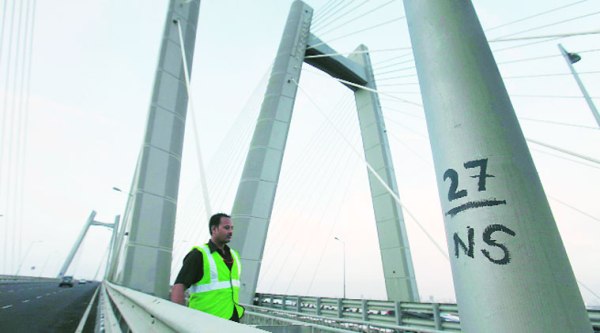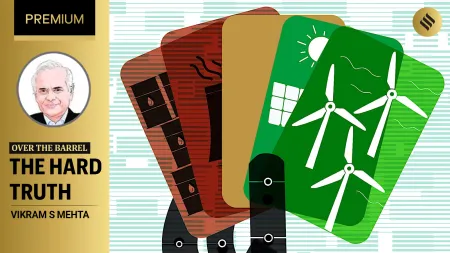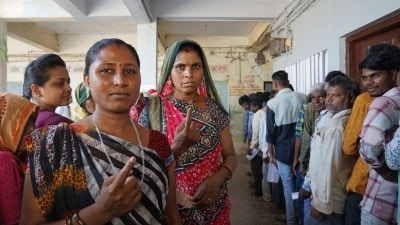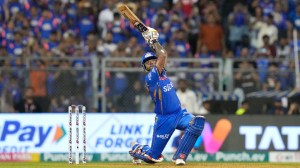- India
- International
Stop! A day in the life of a spotter on the Bandra-Worli
After four people ended their lives by jumping off the Bandra-Worli Sea Link in August,Mumbai police is looking for way to stop a suicide.
 In all, there are 18 ‘spotters’ deployed in shifts to stop people from jumping off. (Source: IE photo by Vasant Prabhu)
In all, there are 18 ‘spotters’ deployed in shifts to stop people from jumping off. (Source: IE photo by Vasant Prabhu)
By: Rohit Alok
September 1, 6.30 am in Mumbai. A man jumps off the Bandra-Worli Sea Link. His last spring, a little scrambled, captured in the grainy dots of Close Circuit Camera Number 1. A ‘spotter’, a private guard employed by the agency manning the sea link, recalls him stopping his WagonR, pushing the door open and running towards the railing. A lone, beaconed police patrol jeep stationed at the spot marks his jump.
At a home in Prabhadevi, around the same time, Gautam Vasudev finds his brother missing. Vikram, a 45-year-old businessman, was last seen in their living room on Sunday night helping his younger son with a school project. Vikram’s elder son had died of brain tumour in 2009, leaving him deeply disturbed, his wife Puja said in her statement to the Bandra police.
A day later, Gautam drove to R N Cooper hospital in Vile Parle. “Vikram’s body was bloated. He didn’t even know how to swim,” says Gautam. His body was found washed up near a shore at Juhu Chowpatty.
Since it was inaugurated in June 2009, eight people have chosen the cable-stayed sea link, officially called the Rajiv Gandhi Sea Link, to end their lives. The eight-laned bridge that spans 5.6 km over the Arabian Sea, avoids 23 traffic signals, cutting commute between the island city and its western suburbs by half. The commissioning agency, Maharashtra State Road Development Corporation (MSRDC), calls it an “intelligent bridge” for its “state-of-the-art system of monitoring, surveillance, information guidance and emergency support”.

The first jump, by debt-ridden Lalit Sheth, owner of Raj Tours and Travels, on August 1, 2012, grabbed front page headlines, but it also exposed loopholes in the sea link’s intelligence. The second jump, in October 2012, showed it could become a habit. Two years later, four suicides in 10 days this August, is “just a coincidence”, says S Jayakumar, deputy commissioner of police, Mumbai Police (Zone 3).
l l l
On the sidewalk, at the Worli end of the bridge, 44-year-old Chandrakant Betkar is positioned at the spot where the carriageway disciplines itself into a four-way lane. He is a new recruit as a ‘spotter’. His job description includes whistling at slowing cars and chasing commuters who step out of their vehicles. He also has to suffer individuals who argue with him in order to take a selfie.
Betkar’s immediate concern is to ensure he doesn’t lose his cap, his third, to the wind on the bridge. His other big challenge is to peer over the four-foot-tall kerbside railing and watch out for errant commuters across the 36-metre-wide double carriageway.
Betkar’s phone is a basic Nokia wrapped in plastic, with a rubber tightly wound around it. He cannot take calls, even if the signal is good. “The wind beats you on the face,” he says.
Betkar and another spotter man the distance over the southbound Worli channel, with the agency positioning four additional spotters on the crosspaths between the two carriageways, from pole 19. That makes them six to a shift.
In all, TRIG, the agency hired to provide manual surveillance, has 18 spotters who cover the bridge in slots between 7.30 am and 3 pm, 3 pm and 11pm and between 11 pm and 7.30 am. Besides, two riders on bikes patrol the sea link every hour, telling bikers and pedestrians that the bridge is off-limits for them.
“It’s dangerous with cars zipping past you at 100 kmph,” admits S P Dubey who is on morning patrol. He looks for “intent”.
A few feet above the bridge’s deck are a separate set of poles with dome-shaped close circuit cameras that complete the token electronic surveillance.
On the north-bound carriageway, they are numbered 1 to 60, starting at the Bandra end. While poles 1 to 19 fall under Bandra police jurisdiction, any incident between poles 19 and 60 is the responsibility of Worli police. That makes pole 19 the most contentious.
Jurisdictional disputes have emerged following two death leaps at this pole. Most suicides, spotters and police confirm, so far have been between poles 19 and 27, on the Bandra channel, where the waters are the most choppy. On August 19, when 65-year-old Lalchand Rathore told his driver to stop, saying he wanted to relieve himself, he chose pole 27, a km away from pole 19.
At the crosspath opposite pole 19 is another 19. Just out of school, this is Amit Thakur’s first job. He has been instructed to whistle if he sees suspicious movement. The Vile Parle resident says keeping a vigil on both carriageways is difficult. “When I’m on one side, I am constantly wondering what is happening on the other end,” he says.
A kilometre away is senior citizen Vishnu Vaiti, who kills time oscillating in the tiny make-shift post on the crosspath. “I could never chase a person because of my build, and the traffic can be scary,” he says. “We don’t have walky-talkies yet and are told to use our own cellphones. In case I cannot get through, I’ve decided I will try and yell out to my colleagues.”
On August 30, around 8.40 am, Vikas Jhore jumped off the bridge from the Worli channel. The BMC employee had had a fight with his wife. From the opposite carriageway, 53-year-old traffic constable Rajinder Jamade saw a woman in a blue sari running after him before he jumped.
At the toll plaza, a supervisor who doesn’t want to be named, says a few people who have got off their cars to jump have stood on the sidewalk, on the left end of the carriageway, probably contemplating their decision.
Once the toll plaza gets a call about a jump, a supervisor has to immediately inform the police. “We tell them the pole number,” says the supervisor. A separate alert goes to the Mumbai Fire Brigade and to Sagari Police Station. Sagari police has the mandate in the state’s water limits. A Maharashtra Security Force personnel and a TRIG security rider are sent to the spot to assist the spotter to mark the point where the person plunged, an information which is then relayed to the rescue authorities.
At 1 pm on a Wednesday last week, a car breaks down. Vaiti leaves his post to help the person and makes sure he relays the information to the control room. He stands very close to the person as he rolls out a spare tyre from the trunk. “You never know what’s in his mind,” he says.
An official at the toll plaza says there is only so much that can be done. “Once a person decides to commit suicide, he will attempt it until he succeeds. If not here, then in front of a train, anywhere. We had an incident on September 2 where a man stopped his car near pole 27 on the south-bound end of the bridge. He got off and stood on the sidewalk, but fled when the guard chased him. He later took a U-turn and stopped his car at pole 19 on the north-bound end. He stood on the sidewalk for a few seconds, until he was stopped by the spotter. He confessed that the choppy waters made it difficult, though he had come determined,” says the official at the toll plaza.
The sea link saw its first suicide in 2012, followed by a spurt in 2014. “They knew where to jump,” says additional commissioner of Police (crime), K M M Prasanna.
Meanwhile, the Mumbai Police continues to look for measures to stop the surge in suicides, with suggestions including increasing the height of the railing to designing a net beneath the bridge to break the fall.
K P Mali, superintending engineer, MSRDC, says every detail on the bridge was studied during the design and execution stage. The current issue, he says, needs a more nuanced approach.
Additional Commissioner Prasanna agrees. “There will always be measures, but how do you stop someone who is determined?”
The police still maintain there is solace in numbers. “The sea link was opened in 2009, and five years hence, there have been eight deaths. This is not like the Brooklyn Bridge or Golden Gate. It’s not open to pedestrians and is not a sight-seeing spot. That’s the difference,” says Jayakumar.
May 07: Latest News
- 01
- 02
- 03
- 04
- 05






































